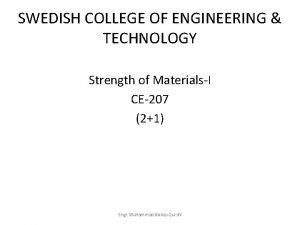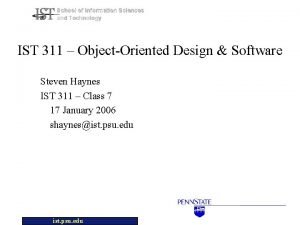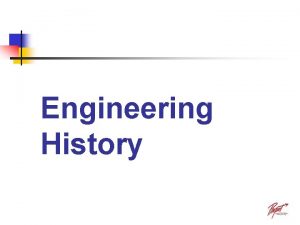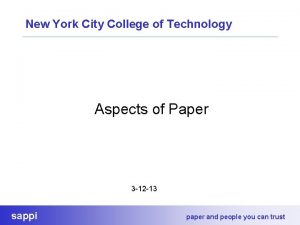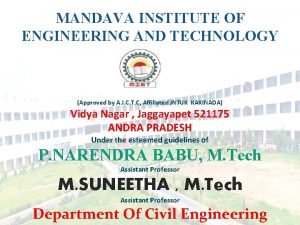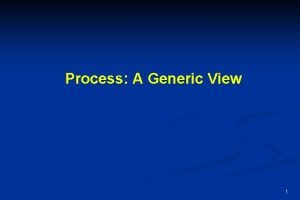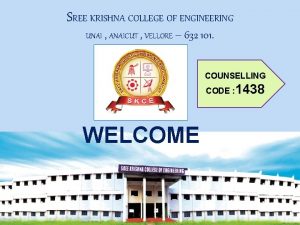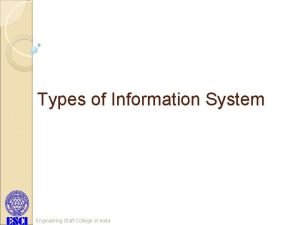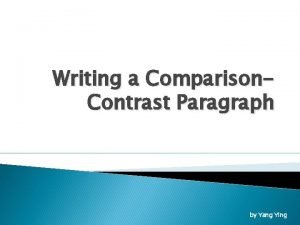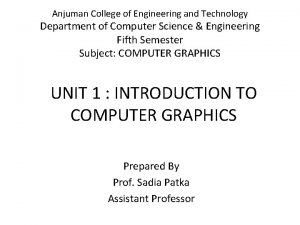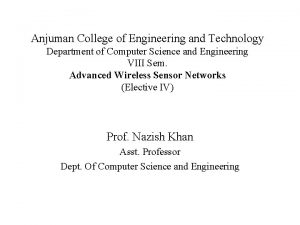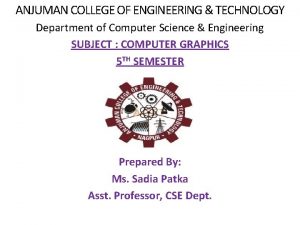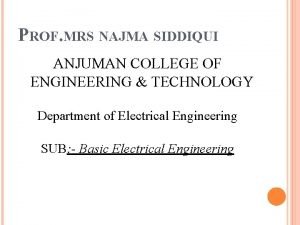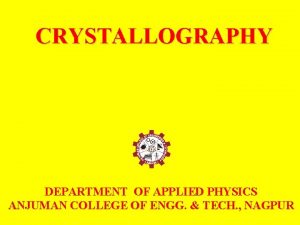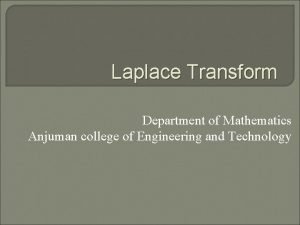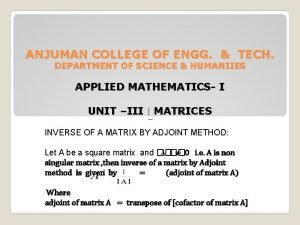START ANJUMAN COLLEGE OF ENGINEERING AND TECHNOLOGY ENGINEERING













































- Slides: 45

START

ANJUMAN COLLEGE OF ENGINEERING AND TECHNOLOGY ENGINEERING MECHANICS PROF. ASIM EJAZ SHEIKH www. asimsheikh 123. wordpress. co m

CONTENTS • FORCE 1. Characteristic of a Force 2. Type of Force • TYPES OF FORCE SYSTEM • RESULTANT OF FORCE SYSTEM : 1. Resultant of Concurrent Forces 2. Resultant of Non-Concurrent Forces • MOMENT OF A FORCES: 1. Moment of Coplanar Forces 2. Moment of a Force about a Point and an Axis PROF ASIM EJAZ SHEIKH

FORCE �An agent which produces or tends to produce , destroy or tends to destroy motion of a body is called force. �Unit of force is Newton. �It is a vector quantity. PROF ASIM EJAZ SHEIKH

�MAGNITUDE: Magnitude of force may be 10 kn etc. �DIRECTION: It has certain fixed direction. �NATURE: It may be tensile or compressive. � POINT OF APPLICATION: Point at which force acts. PROF ASIM EJAZ SHEIKH

�Contact Force �Body Force �Point Force �Distributed Force �External Force �Internal Force �Frictional Force �Wind Force �Hydrostatic Force �Cohesive & Adhesive Force etc. PROF ASIM EJAZ SHEIKH

CONTACT FORCES �Force produced by direct contact of bodies is known as contact force. �It may be of pull type or push type. PROF ASIM EJAZ SHEIKH

BODY FORCES �Forces produced without contact of the bodies is called body force. �It is the force holds together the particles forming the rigid bodies. PROF ASIM EJAZ SHEIKH

�Force acting at a point is called point force. �It acts on a very small area, compared to total surface area. PROF ASIM EJAZ SHEIKH

DISTRIBUTED FORCE When force is distributed over large area it is called distributed force. PROF ASIM EJAZ SHEIKH

EXTERNAL & INTERNAL FORCE �The force exerted by weight on a body is external force, while the resistance offered to retain its shape is called internal force. PROF ASIM EJAZ SHEIKH

�As per Newton’s third law, whenever a body exerts force (action) on other body. The other body exerts similar force on the former body known as reaction. �Action= Reaction PROF ASIM EJAZ SHEIKH

FRICTIONAL FORCE �Resisting force offered during sliding of a body by the surface in contact is called frictoinal forces. PROF ASIM EJAZ SHEIKH

WIND FORCE �Force exerted by wind when it is obstructed by any object. PROF ASIM EJAZ SHEIKH

� Force developed between molecules of same material is called cohesive forces. � Force developed between molecules of different materials is called adhesive force. PROF ASIM EJAZ SHEIKH

HYDROSTATIC FORCE �Force exerted by water on a body when it is obstructed by a body. PROF ASIM EJAZ SHEIKH

SYSTEM OF FORCES When two or more forces act on a body, they are called to form a system of forces. Coplanar Forces Concurrent Forces Collinear Forces Coplanar Concurrent Forces Coplanar non Concurrent Forces Non coplanar Non concurrent Forces Like parallel Forces Unlike parallel Forces Spatial Forces PROF ASIM EJAZ SHEIKH

�Forces whose line of action lie on the same plane, are known as coplanar forces. PROF ASIM EJAZ SHEIKH

�The forces which meet at one point, are known as concurrent forces. PROF ASIM EJAZ SHEIKH

CO-LINEAR FORCES �The forces whose line of action lie on the same line, are known as collinear force. PROF ASIM EJAZ SHEIKH

�Forces which meet at one point & lines of action also lie on the same plane are known as coplanar concurrent forces. PROF ASIM EJAZ SHEIKH

NON-COPLANAR CONCURRENT FORCES �Forces whose line of action do not lie on the same plane, but they meet at one point. PROF ASIM EJAZ SHEIKH

�The forces whose line of action lie on the same plane but they do not meet at one point are known as coplanar non-concurrent forces. PROF ASIM EJAZ SHEIKH

NON-COPLANAR NON-CONCURRENT FORCES �Forces whose line of action do not lie on the same plane & they do not meet at any point. PROF ASIM EJAZ SHEIKH

LIKE PARALLEL FORCES �Forces whose line of action are parallel to each other & all of them act in same direction. PROF ASIM EJAZ SHEIKH

�Forces whose line of action are parallel to each other but all of them do not act in the same direction. PROF ASIM EJAZ SHEIKH

SPATIAL FORCES �Forces acting in the space are known as spatial forces. �Forces acting in space but meeting at one point are known as spatial concurrent forces. PROF ASIM EJAZ SHEIKH

RESOLVED FORCES �Spliting of forces into their component unit is called resolution of forces. �This is the reverse process which consist of expressing a single force in terms of their components. PROF ASIM EJAZ SHEIKH

EXAMPLE Y 6 N 5 N x 35° 50° 20 N 30 N X= 20 cos 35 – 30 sin 50 – 5 = - 11. 5983 Y= 6 – 20 sin 35 – 30 cos 50 = - 24. 7552 PROF ASIM EJAZ SHEIKH R= X 2 Y 2 = 27. 3 N 1 Y tan = 64. 9° = X

�Principle of transmissibility �Principle of superposition �Law of gravitation �Law of parallelogram of forces PROF ASIM EJAZ SHEIKH

F ? = F If we concerns only about the external resultant effects on rigid body. We can slide the force along its line of action. (force can be considered as sliding vector) “A force may be applied at any point on its given line of action without altering the resultant effects external to the rigid body on which it acts. ” PROF ASIM EJAZ SHEIKH

�If two forces acting simultaneously on a particle, be represented in magnitude & direction by the two adjacent sides of a parallelogram: their resultant may be represented in magnitude & direction by the diagonal of the parallelogram which passes through the point of intersection. PROF ASIM EJAZ SHEIKH

RESULTANT OF FORCE SYSTEM 1. Resultant of Concurrent Forces: The resultant of a concurrent force system can be defined as the simplest single force which can replace the original system without changing its external effect on a rigid body. 2. Resultant of Non-Concurrent Forces: The resultant will not necessarily be a single force but a force system comprising a force or a couple or a force and a couple. PROF ASIM EJAZ SHEIKH

RESULTANT OF FORCE SYSTEM Types of Force System PROF ASIM EJAZ SHEIKH

RESULTANT OF FORCE SYSTEM 1. Resultant of Concurrent Forces: The resultant of a concurrent force system can be defined as the simplest single force which can replace the original system without changing its external effect on a rigid body. Coplanar Concurrent Force Non-Coplanar Concurrent Force 2. Resultant of Non-Concurrent Forces: The resultant will not necessarily be a single force but a force system comprising a force or a couple or a force and a couple. Coplanar Non-Concurrent Force Non-Coplanar and Non-Concurrent Force PROF ASIM EJAZ SHEIKH

Resultant of Coplanar Concurrent Forces: PROF ASIM EJAZ SHEIKH

Example: Four forces act on a body as shown in Figure. Determine the resultant of the system of forces. PROF ASIM EJAZ SHEIKH

Resultant of Coplanar Concurrent Forces Solution PROF ASIM EJAZ SHEIKH

PROF ASIM EJAZ SHEIKH

Resultant of Coplanar Concurrent Forces: • If three non-coplanar forces F 1, F 2 & F 3 are acting at a point 0 in a body, the resultant R 12 of the two forces F, and F 2 can be determined by law of parallelogram of forces. • Thus, the vector sum of a non-coplanar system of concurrent forces F 1, F 2 and F 3 is given by: PROF ASIM EJAZ SHEIKH

PROF ASIM EJAZ SHEIKH

Resultant of Coplanar Non-Concurrent Forces: Obtained by adding two forces at a time and then combining their sums. The three forces Fl, F 2 and F 3 shown in Figure 1. 26 may be combined by first adding any two forces such as F 2 and F 3. They may be moved along their lines of action to their point of concurrency A by the principle of transmissibility. PROF ASIM EJAZ SHEIKH

Their sum R 1 is formed by the law of parallelogram of forces. The force R 1 may then be combined with F 1 by the parallelogram law at their point of concurrency B to obtain the resultant R of the three given forces. Here, the order of combination of the forces is immaterial as may be verified by combining them in a different sequence. Now, the force R may be applied at any point on its established line of action. PROF ASIM EJAZ SHEIKH

Resultant of Non-Coplanar and Non- Concurrent Forces: • The resultant of a non-parallel, non-coplanar, nonconcurrent force system can be a single force or a couple. • The resultant is a force when ∑F is different from zero and a couple when ∑F is equal to zero unless ∑M 0 is also zero in which case the system is in equilibrium and the resultant is zero. PROF ASIM EJAZ SHEIKH

Now, the resultant couple is given by: And the direction of the resultant couple may be specified by its direction cosines, which are PROF ASIM EJAZ SHEIKH
 The silenced by nadia anjuman
The silenced by nadia anjuman Thakur college of engineering and technology
Thakur college of engineering and technology College of engineering science and technology
College of engineering science and technology Parasitic food chain example
Parasitic food chain example Swedish college of engineering and technology
Swedish college of engineering and technology Forevers gotta start tonight
Forevers gotta start tonight Triage jump start
Triage jump start Studentp
Studentp Bellevue college running start
Bellevue college running start Ist 311
Ist 311 Trent global college review
Trent global college review How did engineering start
How did engineering start Sappy paper
Sappy paper Nara national college of technology
Nara national college of technology El camino rad tech
El camino rad tech Architectural technology sheridan
Architectural technology sheridan Dublin institute of technology college of business
Dublin institute of technology college of business Lee college process technology
Lee college process technology Kingsmead intranet
Kingsmead intranet Vidhyadeep institute of engineering and technology
Vidhyadeep institute of engineering and technology Fcc office of engineering and technology
Fcc office of engineering and technology Accreditation board for engineering and technology
Accreditation board for engineering and technology Mandava institute of engineering and technology
Mandava institute of engineering and technology Asd college college readiness program
Asd college college readiness program Early college high school at midland college
Early college high school at midland college Zeal dnyanganga college of engineering and research
Zeal dnyanganga college of engineering and research Ucf computer engineering
Ucf computer engineering Uc ceas
Uc ceas Reel to reel institute
Reel to reel institute Layer technology in software engineering
Layer technology in software engineering Generic view of software engineering
Generic view of software engineering Can technology replace social engineering
Can technology replace social engineering Hijjawi faculty for engineering technology
Hijjawi faculty for engineering technology Fromme423
Fromme423 Kate gleason college of engineering
Kate gleason college of engineering Tagore engineering college rathinamangalam
Tagore engineering college rathinamangalam St.anns college chirala materials
St.anns college chirala materials Sree krishna college of engineering vellore
Sree krishna college of engineering vellore Gec khagaria
Gec khagaria College of engineering, king abdulaziz university
College of engineering, king abdulaziz university Engineering staff college of india
Engineering staff college of india Feng's classification in computer architecture
Feng's classification in computer architecture Forward engineering and reverse engineering
Forward engineering and reverse engineering How to start compare and contrast paragraph
How to start compare and contrast paragraph Discuss
Discuss Comparison paragraph
Comparison paragraph




